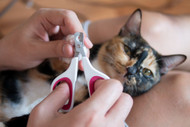Do you need to trim your cat’s claws?
24th Jul 2024
Much like our human nails, cat’s claws are continuously growing. Most cats will naturally keep their claws to an appropriate length by scratching, climbing, and general use of their claws. However, some cats, particularly elderly or arthritic cats with limited mobility or less active, indoor cats might need help keeping their claws trimmed.
You should always make sure that your cat has a scratching post available to be able to keep their claws at a comfortable level.
There are several signs that your cat’s claws are becoming too long and may need human intervention:
- Their claws are getting caught in things such as carpets and blankets, and you are continually finding yourself helping your cat to release themselves.
- You can hear the tap-tap of their claws as they walk across hard surfaces.
- Their claws are clearly visible when your cat is at rest.
- They have stopped using their scratching post or it appears that it is uncomfortable for them to do so.
- In extreme cases, you might notice that the claws are growing into your cat’s paw pads. If this happens, you will need to make a vet appointment to have the claws trimmed professionally and to assess for any sign of infection.
If you have a new kitten, it is a good idea to get them used to the idea of having their claws trimmed from an early age, especially if you intend to raise them as an indoor cat. To train them, you can make their paws part of your regular stroking routine. Most cats do not like having theirs paws and legs touched, so be sure to do this gradually by stroking their body and then extending to the tops of their legs. Over time, as your cat gets used to this you will be able to stoke further down their legs until you are touching their paws. Always listen to your cat’s body language and go at their own pace. Hopefully, if you keep up with this, it will not be so stressful for you, or your cat when you introduce the claw clippers.
How do I clip my cat’s claws?
- Preparation is key – be sure that you have all the equipment you will need before you get your cat ready. This will obviously include the claw clippers (make sure you have clippers suitable for a cat, and definitely do not use human nail clippers as these are the wrong shape and will hurt your cat). Also remember to have some treats to hand, and a comfy blanket or cushion for your cat to sit on. You may also find it easier to have a second person to help you with the clipping.
- Get a good grip – once you have got your cat comfortable on your lap, you will need to get a gentle, but firm grip of your cat’s paw. You will need to apply a very small amount of pressure to the toe to expose the claw. Do not squeeze, as this will be uncomfortable for your cat. You can practice this step to familiarise your cat with the process.
- Ready your clippers – It is really important to only clip the white part at the very end of your cat’s claws. You must avoid the pinkish quick at the bottom of the claw, if you cut this, it will bleed and cause your cat a great deal of pain.
- Time for a reward! – Once you have done the first paw, thank your cat for their good behaviour with a treat. Judge how they are feeling after this, most cats will find this distressing and want a break, so let them go and repeat the above steps with the next paw another day. Of course, if your cat is still in a good mood and happy to continue, you can move straight onto their next paw!
As always with cats, go at their own pace as they can become easily distressed. It you are patient with them, many cats will become accustomed to having their claws trimmed and this will really take the stress out of the situation for both of you. Some cats may never become compliant enough to let you trim their claws, in which case, you may need to consult with your vet.
